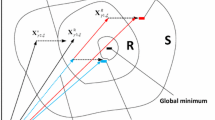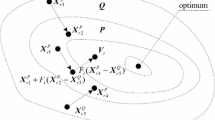Abstract
Population structure has an impact on the performance of metaheuristic algorithms. To better improve the performance of differential evolution (DE), an elite-guided hierarchical differential evolution algorithm (EHDE) is proposed. First, an elite-guided hierarchical mutation mechanism is presented, which integrates elite elements into the hierarchical population structure. During each generation, the population is divided into three groups according to fitness values, each group playing a unique role in its hierarchy. The best individual on the top layer is used to avoid the local optimal by random reinitialization or Lévy flight. The (k − 1) elite individuals on the middle layer focus on the local search around the best individual. The remaining non-elite individuals on the bottom layer pay more attention to a more considerable range search by the guidance of the k elite individuals. Second, to accommodate diverse optimization problems and seek the balance between exploration and exploitation, the adaptive strategy of EHDE control parameters has added the random component and the time-varying component. Finally, for the sake of evaluating the performance of EHDE, sensitivity analysis to the size of elite individuals, efficiency analysis of the control parameters adaptive strategy, and comparisons with nine advanced DE variants and three non-DE algorithms on 29 universal benchmark function in terms of convergence accuracy and convergence speed have been taken out. All the obtained results show that the proposed EHDE has excellent optimization performance.







Similar content being viewed by others
Data availability
The data used to support the findings of this study are available from the corresponding author upon request.
References
Dorronsoro B, Bouvry P (2011) Improving classical and decentralized differential evolution with new mutation operator and population topologies[J]. IEEE Trans Evol Comput 15(1):67–98. https://doi.org/10.1109/TEVC.2010.2081369
Marco T (2005) Spatially structured evolutionary algorithms artificial evolution in space and time. Springer, Berlin, Heidelberg. https://doi.org/10.1007/3-540-29938-6
Fernandes CM, Fachada N, Laredo JLJ, Guervós JJM (2020) Population sizing of cellular evolutionary algorithms[J]. Swarm Evol Comput 58:100721. https://doi.org/10.1016/j.swevo.2020.100721
Holland JH (1975) Adaptation in natural and artificial systems, 2nd edn. MIT Press, Cambridge
Storn R, Price K (1997) Differential evolution: a simple and efficient adaptive scheme for global optimization over continuous spaces[J]. J Glob Optim 11(4):341–359. https://doi.org/10.1023/A:1008202821328
Kennedy J, Eberhart RC (1995) Particle swarm optimization. 1995 IEEE Int Conf Neural Netw IEEE 1942–1948. https://doi.org/10.1109/icnn.1995.488968
Yang X-S, Deb S (2009) Cuckoo search via Lévy flights. Proceedings of the 2009 World Congress on Nature & Biologically Inspired Computing (NaBIC 2009). IEEE Publications, USA; pp 210–214. https://doi.org/10.1109/NABIC.2009.5393690
Karaboga D, Basturk B (2007) A powerful and efficient algorithm for numerical function optimization: artificial bee colony (ABC) algorithm[J]. J Glob Optim 39(3):459–471. https://doi.org/10.1007/s10898-007-9149-x
He S, Wu QH, Saunders JR (2009) Group search optimizer: an optimization algorithm inspired by animal searching behavior[J]. IEEE Trans Evol Comput 13(5):973–990
Meng Z, Pan JS (2016) Monkey King Evolution: A new memetic evolutionary algorithm and its application in vehicle fuel consumption optimization[J]. Knowl-Based Syst 97:144–157
Jain M, Singh V, Rani A (2019) A novel nature-inspired algorithm for optimization: squirrel search algorithm[J]. Swarm Evol Comput 44:18–175. https://doi.org/10.1016/j.swevo.2018.02.013
Faramarzi A, Heidarinejad M, Stephens B, Mirjalili S (2020) Equilibrium optimizer: a novel optimization algorithm[J]. Knowl-Based Syst 191:105190. https://doi.org/10.1016/j.knosys.2019.105190
Mohamed AW, Hadi AA, Mohamed AK (2020) Gaining-sharing knowledge based algorithm for solving optimization problems: a novel nature-inspired algorithm[J]. Int J Mach Learn Cybern 11(7):1501–1529. https://doi.org/10.1007/s13042-019-01053-x
Lynn N, Ali MZ, Suganthan PN (2018) Population topologies for particle swarm optimization and differential evolution[J]. Swarm Evol Comput 39:24–35. https://doi.org/10.1016/j.swevo.2017.11.002
Meng XB, Liu Y, Gao XZ, Zhang HZ (2014) A new bio-inspired algorithm: chicken swarm optimization. In: international conference in swarm intelligence (86–94). Cham: Springer. https://doi.org/10.1007/978-3-319-11857-4_10
Mirjalili S, Lewis A (2016) The whale optimization algorithm[J]. Adv Eng Softw 95:51–67. https://doi.org/10.1016/j.advengsoft.2016.01.008
Mirjalili S, Mirjalili SM, Lewis A (2014) Grey wolf optimizer[J]. Adv Eng Softw 69:46–61. https://doi.org/10.1016/j.advengsoft.2013.12.007
Zhang YY, Jin ZG (2020) Group teaching optimization algorithm: a novel metaheuristic method for solving global optimization problems[J]. Expert Syst Appl 113246:113246. https://doi.org/10.1016/j.eswa.2020.113246
Zhang JQ, Sanderson AC (2009) JADE: adaptive differential evolution with optional external archive[J]. IEEE Trans Evol Comput 13(5):945–958. https://doi.org/10.1109/TEVC.2009.2014613
Mohamed AW, Mohamed AK (2017) Adaptive guided differential evolution algorithm with novel mutation for numerical optimization[J]. Int J Mach Learn Cybern 10(4):253–277. https://doi.org/10.1007/s13042-017-0711-7
Wang SH, Li YZ, Yang HY (2017) Self-adaptive differential evolution algorithm with improved mutation mode[J]. Appl Intell 47(3):644–658. https://doi.org/10.1007/s10489-017-0914-3
Mohamed AW, Suganthan PN (2018) Real-parameter unconstrained optimization based on enhanced fitness-adaptive differential evolution algorithm with novel mutation[J]. Soft Comput 22(10):3215–3235. https://doi.org/10.1007/s00500-017-2777-2
Wang SH, Li YZ, Yang HY (2019) Self-adaptive mutation differential evolution algorithm based on particle swarm optimization[J]. Appl Soft Comput 81:105496. https://doi.org/10.1016/j.asoc.2019.105496
Mohamed Ali W, Hadi Anas A, Jambi KM (2019) Novel mutation strategy for enhancing SHADE and LSHADE algorithms for global numerical optimization[J]. Swarm Evol Comput 50:100455. https://doi.org/10.1016/j.swevo.2018.10.006
Li SJ, Gu Q, Gong WY, Ninga B (2020) An enhanced adaptive differential evolution algorithm for parameter extraction of photovoltaic models[J]. Energy Convers Manag 205:112443. https://doi.org/10.1016/j.enconman.2019.112443
Cheng JX, Zhang GX, Neri F (2013) Enhancing distributed differential evolution with multicultural migration for global numerical optimization[J]. Inf Sci 247:72–93. https://doi.org/10.1016/j.ins.2013.06.011
Zhang CM, Chen J, Xin B (2013) Distributed memetic differential evolution with the synergy of Lamarckian and Baldwinian learning[J]. Appl Soft Comput 13(5):2947–2959. https://doi.org/10.1016/j.asoc.2012.02.028
De Falco I, Della Cioppa A, Maisto D, Scafuri U, Tarantino E (2014) An adaptive invasion-based model for distributed differential evolution[J]. Inf Sci 278:653–672. https://doi.org/10.1016/j.ins.2014.03.083
Wu GH, Mallipeddi R, Suganthan PN, Wang R, Chen HK (2016) Differential evolution with multi-population based ensemble of mutation strategies[J]. Inf Sci 329(C):329–345. https://doi.org/10.1016/j.ins.2015.09.009
Wu GH, Shen X, Li HF, Chen HK, Lin AP, Suganthan PN (2018) Ensemble of differential evolution variants[J]. Inf Sci 423:172–186. https://doi.org/10.1016/j.ins.2017.09.053
Tong L, Dong M, Jing C (2018) An improved multi-population ensemble differential evolution[J]. Neurocomputing. 290:130–147. https://doi.org/10.1016/j.neucom.2018.02.038
Li XY, Wang L, Jiang QY, Li N (2020) Differential evolution algorithm with multi-population cooperation and multi-strategy integration[J]. Neurocomputing. 421:285–302. https://doi.org/10.1016/j.neucom.2020.09.007
Chen X (2020) Novel dual-population adaptive differential evolution algorithm for large-scale multi-fuel economic dispatch with valve-point effects[J]. Energy. 203:117874. https://doi.org/10.1016/j.energy.2020.117874
Das S, Abraham A, Chakraborty UK, Konar A (2009) Differential evolution using a neighborhood-based mutation operator[J]. IEEE Trans Evol Comput 13(3):526–553. https://doi.org/10.1109/TEVC.2008.2009457
Liao JL, Cai YQ, Wang T, Chen YH (2016) Cellular direction information based differential evolution for numerical optimization: an empirical study[J]. Soft Comput 20(7):2801–2827. https://doi.org/10.1007/s00500-015-1682-9
He W, Gong WY, Wang L, Yan XS, Hu CY (2019) Fuzzy neighborhood-based differential evolution with orientation for nonlinear equation systems [J]. Knowl-Based Syst 182:104796. https://doi.org/10.1016/j.knosys.2019.06.004
Tian MN, Gao XB (2018) Differential evolution with neighborhood-based adaptive evolution mechanism for numerical optimization[J]. Inf Sci 478:422–448. https://doi.org/10.1016/j.ins.2018.11.021
Peng H, Guo ZL, Deng CS, Wu ZJ (2018) Enhancing differential evolution with random neighbors based strategy[J]. J Comput Sci 26:501–511. https://doi.org/10.1016/j.jocs.2017.07.010
Tian MN, Gao XB, Yan XQ (2019) Performance-driven adaptive differential evolution with neighborhood topology for numerical optimization[J]. Knowl-Based Syst 188:105008. https://doi.org/10.1016/j.knosys.2019.105008
Cai YQ, Wu DW, Zhou Y, Fu SK, Tian H, Du YQ (2020) Self-organizing neighborhood-based differential evolution for global optimization [J]. Swarm Evol Comput 56:100699. https://doi.org/10.1016/j.swevo.2020.100699
Segredo E, Lalla-Ruiz E, Hart E, Voß S (2020) A similarity-based neighbourhood search for enhancing the balance exploration-exploitation of differential evolution[J]. Comput Oper Res 117:104871. https://doi.org/10.1016/j.cor.2019.104871
Dhahri H, Alimi AM, Abraham A (2012) Hierarchical multi-dimensional differential evolution for the design of beta basis function neural network[J]. Neurocomputing. 97:131–140. https://doi.org/10.1016/j.neucom.2012.04.008
Di Maio F, Baronchelli S, Zio E (2014) Hierarchical differential evolution for minimal cut sets identification: application to nuclear safety systems [J]. Eur J Oper Res 238(2):645–652. https://doi.org/10.1016/j.ejor.2014.04.021
Tardivo ML, Caymes-Scutari P, Bianchini G, Méndez-Garabetti M (2017) Hierarchical parallel model for improving performance on differential evolution. Concurr Comput Pract Exp 29(10):E4087. https://doi.org/10.1002/cpe.4087
Liu ZG, Ji XH, Yang Y (2019) Hierarchical differential evolution algorithm combined with multi-cross operation [J]. Expert Syst Appl 130:276–292. https://doi.org/10.1016/j.eswa.2019.04.040
Tanabe R, Fukunaga A (2013) Success-history based parameter adaptation for differential evolution[C]// 2013 IEEE congress on evolutionary computation. Cancun, pp 71–78. https://doi.org/10.1109/CEC.2013.6557555
Zhang SX, Zheng LM, Tang KS, Zheng SY, Chan WS (2019) Multi-layer competitive-cooperative framework for performance enhancement of differential evolution[J]. Inf Sci 482:86–104. https://doi.org/10.1016/j.ins.2018.12.065
Liu QX, Du SZ, Wyk BJV, Sun YX (2020) Double-layer-clustering differential evolution multimodal optimization by speciation and self-adaptive strategies[J]. Inf Sci 545:465–486. https://doi.org/10.1016/j.ins.2020.09.008
Cui LZ, Li GH, Zhu ZX, Lin QZ, Wong KC, Chen JY, Lu N, Lu J (2018) Adaptive multiple-elites-guided composite differential evolution algorithm with a shift mechanism[J]. Inf Sci 422:122–143. https://doi.org/10.1016/j.ins.2017.09.002
Barthelemy P, Bertolotti J, Wiersma DS (2008) A levy flight for light [J]. Nature 453(7194):495–498
Mantegna RN (1994) Fast, accurate algorithm for numerical simulation of levy stable stochastic processes[J]. Phys Rev E 49(5):4677–4683. https://doi.org/10.1103/PhysRevE.49.4677
Jensi R, Jiji GW (2016) An enhanced particle swarm optimization with levy flight for global optimization[J]. Appl Soft Comput 43:248–261. https://doi.org/10.1016/j.asoc.2016.02.018
Liang JJ, Qu BY, Suganthan PN, Chen Q (2015) Problem definition and evaluation criteria for the CEC 2015 competition on learning-based real-parameter single objective optimization. In: Technical Report, Nanyang Technological University Singapore. http://www.ntu.edu.sg/home/EPNSugan/index_files/CEC2015
Awad NH, Ali MZ, Suganthan PN, Liang JJ, Qu BY (2016) Problem definitions and evaluation criteria for the CEC 2017 Special Session and Competition on Single Objective Real-Parameter Numerical Optimization. In: Technical Report, Nanyang Technological University Singapore. http://www.ntu.edu.sg/home/EPNSugan/index_files/CEC2017
Bilal PM, Zaheer H, Garcia-Hernandez L, Abraham A (2020) Differential evolution: a review of more than two decades of research[J]. Eng Appl Artif Intell 90:103479. https://doi.org/10.1016/j.engappai.2020.103479
Derrac J, García S, Molina D, Herrera F (2011) A practical tutorial on the use of nonparametric statistical tests as a methodology for comparing evolutionary and swarm intelligence algorithms[J]. Swarm Evol Comput 1(1):3–18. https://doi.org/10.1016/j.swevo.2011.02.002
Castillo O, Melin P, Ontiveros E, Peraza C, Ochoa P, Valdez F, Soria J (2019) A high-speed interval type 2 fuzzy system approach for dynamic parameter adaptation in metaheuristics[J]. Eng Appl Artif Intell 85:666–680. https://doi.org/10.1016/j.engappai.2019.07.020
Ochoa P, Castillo O, Soria J (2020) High-speed interval Type-2 fuzzy system for dynamic crossover parameter adaptation in differential evolution and its application to controller optimization[J]. Int J Fuzzy Syst 22(2):414–427. https://doi.org/10.1007/s40815-019-00723-w
Ochoa P, Castillo O, Soria J (2020) Optimization of fuzzy controller design using a differential evolution algorithm with dynamic parameter adaptation based on Type-1 and interval Type-2 fuzzy systems[J]. Soft Comput 24(1):193–214. https://doi.org/10.1007/s00500-019-04156-3
Funding
This research was funded by the National Natural Science Foundation of China, grant number U1833128.
Author information
Authors and Affiliations
Contributions
Conceptualization: Xuxu Zhong
Methodology: Xuxu Zhong
Validation: Xuxu Zhong, Peng Cheng
writing—original draft preparation: Xuxu Zhong
writing—review and editing: Xuxu Zhong and Peng Cheng
project administration: Peng Cheng
funding acquisition: Peng Cheng
Corresponding author
Ethics declarations
Conflict of interest
The authors declare there is no conflict of interests regarding the publication of this paper.
Additional information
Publisher’s note
Springer Nature remains neutral with regard to jurisdictional claims in published maps and institutional affiliations.
Rights and permissions
About this article
Cite this article
Zhong, X., Cheng, P. An elite-guided hierarchical differential evolution algorithm. Appl Intell 51, 4962–4983 (2021). https://doi.org/10.1007/s10489-020-02091-7
Accepted:
Published:
Issue Date:
DOI: https://doi.org/10.1007/s10489-020-02091-7




